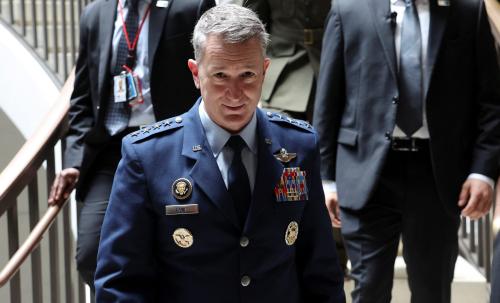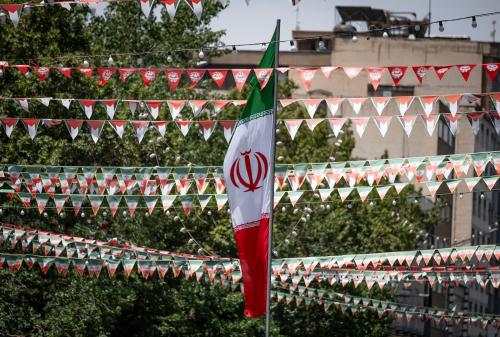In war, there are always surprises. For most Americans, the biggest surprise of the war so far has been the ability of Iraqi irregulars to hamstring the plans of the Allied military command. The irregulars have threatened Allied supply lines and put up fierce resistance in Iraq’s cities, forcing American and British units to slow their forward progress on the ground and deploy additional forces for route security and urban clearing operations.
However, in the emotional fashion common to wartime, the impact and implications of these developments have been exaggerated. Neither Iraq’s high command nor its military forces have shown capabilities significantly beyond previously known levels. Iraq’s military high command was always a competent group, capable of making the most of the highly limited forces at its disposal. A significant proportion of Iraq’s soldiery (including the Republican Guard and the irregulars of the Fidayin Saddam and Saddam’s other security services) have shown considerable tenacity but little more skill than in previous conflicts. They have learned some new tactics—although this too appears to have been exaggerated in early reports—which they are putting to good use, but here as well these modest improvements are highly unlikely to prove decisive.
To a considerable extent, the surprise of so many commentators and even, apparently, of many U.S. military personnel appears to be derived from a superficial understanding of Iraqi performance during the 1991 Persian Gulf War. Out of that war came a set of assumptions about the Iraqi armed forces—that they were undisciplined, uncommitted, unwilling to fight, and incapable of learning—that were only partially true. In fact, Iraqi military history at least since 1948 has consistently demonstrated that Iraqi troops are capable of fighting ferociously in static defensive operations and straightforward attacks, that they can learn lessons from previous experiences and develop new approaches based on those lessons, and that their generals are reasonably competent. On the other hand, many Iraqi troops are poorly motivated and disciplined and offer very little resistance when placed in fluid battlefield conditions, Iraqi forces tend to learn slowly and in disjointed fashion, and their tactical leadership tends to be very poor. These problems have been among the most deleterious to Iraqi military performance over the past 55 years and there is little in the first two weeks of the war to indicate that Iraq has actually overcome these problems.
LESSONS LEARNED
Until the war is over and we have access to Iraqi files—and perhaps high-ranking military officials—it is impossible to know just how Iraq approached the question of a war with the United States. However, Iraq does appear to have consciously studied a number of foreign examples and developed new tactics to give it some chance against the U.S. forces. In particular, Iraq does appear to have latched onto the U.S. experience in Somalia in 1993-94 as being a clear example of how a weak nation can defeat the United States of America. Iraq’s reliance on irregulars, particularly in its cities, appears clearly patterned on the Somali “technicals”—lightly armed militiamen who served Somali warlords such as Mohammed Farah Aidid. Iraq’s rather unsophisticated copying of the Somali experience can be seen in its adoption of Somali tactics regardless of whether they were appropriate for Iraq’s unique circumstances. For example, the most problematic tactic of Iraq’s irregulars is their use of Iraq’s civilians as human shields—quite literally firing from out of crowds or from behind women and children as the Somalis did. On the other hand, Iraq’s use of pickup trucks and SUVs mounted with crew-served weapons (machine guns, grenade launchers, antiaircraft guns) has probably been deleterious to the Iraqi irregulars because these vehicles are ideal targets for American tanks and armored personnel carriers.
However, the Iraqis also appear to have looked to other models for guidance on how the weak can defeat the strong. Hizballah’s war against Israel in Lebanon and the terrorist campaigns by Hamas and Palestinian Islamic Jihad against Israel proper also appear to have furnished examples for Baghdad. Its employment of suicide bombers at least inside the country, but possibly in Kuwait as well, was undoubtedly spurred by these other models.
Moreover, the resort to methods derived from these other experiences probably served Baghdad’s purposes in two ways. The first is the obvious one that these groups had taken on much more powerful and technologically sophisticated foes and caused them considerable pain—much greater pain than Iraq had inflicted on the U.S.-led coalition in 1991. Yet a second goal was likely: that the Iraqis were tapping into an important source of psychological analogies that they probably hoped would generate fear in American minds. The collective American memory of Somalia, especially after the powerful film version of Mark Bowden’s book Blackhawk Down, is a searing one. Likewise, the relentless images of a powerful Israeli Army frustrated by Hizballah guerrilla tactics and Palestinian terrorist operations conjure immediate fears in the Western psyche. At some level, the Iraqis appear to have recognized the impact of these memories on the American public and consciously employed them to try to heighten American public anxiety about the war in Iraq.
A SIGN OF SOMETHING BIGGER?
While it is clear that Iraqi forces have learned some useful new lessons, there is little evidence of any significant improvement in their capabilities. For the most part, they are doing well what they have always done well and doing poorly what they always do poorly. For the past 60 years, several patterns of combat effectiveness (and ineffectiveness) have been constants in Iraqi military operations. On the positive side, Iraqi troops often fight extremely hard both when defending fixed positions and when conducting simple, direct assaults. From the Golan Heights—where in 1973 Iraqi forces launched repeated attacks on dug-in Israeli armor even though they inflicted little damage on the Israelis—to the desert of the Kuwaiti Theater of Operations—where in 1991 the Republican Guard divisions fought to the death against the U.S. VII Corps during the battles of Wadi al-Batin and Madinah ridge—Iraq’s soldiery has proven that its tenacity should not be underestimated. However, Iraqi forces have shown little ability in maneuver warfare or combined arms operations and have had considerable difficulty employing their weapons to the full extent of their capability. Thus, in all of these battles, Iraq’s forces have often fought very hard, but not very well.
This pattern appears to be holding true today, as best we can tell 5,000 miles from the battlefield. Saddam’s loyalists have shown themselves willing to launch determined attacks on U.S. and British forces and to fight back fiercely when attacked. However, they have shown little skill in these attacks. During the first 13 days of the war, roughly 60 British and American troops have been killed, a number of those in accidents and friendly fire incidents. Although these are all tragedies for the soldiers and Marines who gave their lives, by military standards such casualties are extremely light. Moreover, if the irregulars were going to cause significant harm to U.S. and British forces, the moment of greatest likelihood for them to have done so was in their initial attacks—which did catch the U.S. and British forces off guard. Indeed, now that Allied troops know what to look for and have brought up reinforcements to help clear key cities and defend the supply lines, the number killed by the irregulars has fallen noticeably.
Nor should we exaggerate the number of Iraqis who are fighting. According to U.S. and British military reports, in each of the major towns entered by U.S. and British forces—al-Basrah, an-Nasiriyah, Umm Qasr, an-Najaf, as-Samawah, Karbala, and al-Hillah—only several thousand irregulars have fought. We may never have an accurate number of exactly how many Iraqis have actually fought, and the numbers may well be higher than those claimed by U.S. Central Command, but it seems unlikely that they would be significantly off, say by an order of magnitude. These estimates square with both the low number of casualties Allied forces have taken and the descriptions of specific firefights filed by embedded reporters, all of which suggest that even the largest engagements include no more than about a thousand irregulars. This suggests that only a rather small percentage of Iraq’s military and paramilitary forces (which altogether number roughly 1 million men and in the south probably number as many 400,000) are fighting.
UNDERSTANDING THE DIFFICULTIES
By any absolute standard of military operations, the U.S. and British invasion of Iraq is going extraordinarily well. It can only be judged as encountering difficulties by relative standards. To put it in the most obvious fashion: if U.S. and British forces were not having those difficulties, the campaign would be going even better. More to the point, many Americans (including in the U.S. armed forces) expected the war to go even better than it has, and there are reasonable arguments that it could have gone even better if key issues had been addressed differently. Nevertheless, most of the difficulties encountered so far have arisen principally from specific elements of the U.S. operation and the difficult terrain, and not from new capabilities on the part of the Iraqis.
The plan developed by U.S. Central Command was very audacious. That is another way of saying that it contained inherent risks. In particular, the plan emphasized pushing the bulk of the maneuver units up to Baghdad over clearing key urban areas and allocating forces for the defense of U.S. supply lines. These risks were built into in the plan and appear to have been accepted in large part because the U.S. military expected to encounter only relatively light resistance in southern Iraq and that the people of southern Iraq would actively assist in their liberation. The difficulties arose because U.S. and British forces encountered stiffer than expected resistance and the people of southern Iraq have been so cowed by Saddam’s terror over the last three decades that while they do appear to passively support the operation, they are unwilling to take action. When these underlying assumptions did not pan out, they immediately exposed the risks inherent in the plan.
The second problem U.S. and British forces have faced is the terrain. In 1991, the Iraqis deployed their army in the middle of a featureless desert that provided almost limitless fields of fire and almost no cover from air or ground attack. Under those circumstances, they were virtually helpless against the forces of the U.S.-led coalition. This environment played entirely to the advantages of U.S. forces in maneuver warfare, combined arms operations, and long-range attack while highlighting the crippling weakness of Iraqi forces in these same areas. As a result, in the desert U.S. and British forces ran circles around the Iraqis (almost literally) and were able to stand back and obliterate Iraqi forces from ranges at which the Iraqis often could not even see their attackers.
This time around, the Iraqis have learned the lesson of the Gulf War and are instead sticking to much more difficult terrain: cities, built-up areas, forests, palm plantations, and the like. In this terrain, it is more difficult for U.S. and British forces to maneuver and virtually impossible to get long-range shots at the Iraqis. Instead, the Allied units are forced to close with the Iraqis, giving Saddam’s loyalists a much better chance to fight back—and in typical Iraqi fashion, they are fighting back hard when given the chance to do so.
The experience of the 11th Aviation Brigade on March 24 is instructive. On that day, 32 of its Apache Longbow helicopters were sent to attack a Republican Guard armored formation near Karbala and suffered withering fire that damaged virtually all of the helicopters. At least according to the reports of the embedded journalists, this was a surprise to the Apache pilots. It should not have been. During the Gulf War, Apaches operated with virtual impunity against the Guard because in the desert they could do what they were built to do: stand back several kilometers and launch Hellfire missiles at exposed Iraqi tanks laid out as if on a table top for them. Throughout the first Gulf War, Republican Guard units put up terrific amounts of anti-aircraft fire whenever they were able to do so—early on during the air campaign, Central Command tried allowing A-10 attack jets to strike Guard formations from lower altitudes only to immediately lose four planes to anti-aircraft fire, prompting CENTCOM to rescind the order. This time around, in the more confined terrain of central Iraq, the Apaches were forced to get in close to mount their attacks and that exposed them to the same ferocious anti-aircraft fire that the Guard divisions put up in 1991, but this time at closer ranges, from positions hidden in buildings and vegetation, and from multiple vectors (because the helos were flying into the Republican Guard positions rather than just shooting at them from a distance).
THE PERILS OF OPTIMISM
It is almost certainly the case that one of those most surprised by the extent of the problems the Iraqi irregulars have so far caused the Allied invasion force is Saddam Husayn himself. Saddam’s speeches before the war, the statements of other Iraqi officials, the disposition of Iraqi forces, and other information all indicate that Saddam was not counting on his Fidayin or other irregulars to do much more than slow the Allied advance and perhaps inflict some modest casualties. (And in truth, this remains an accurate assessment of the discomfiture they have so far achieved.) Saddam always expected to win the war by defeating American forces at Baghdad, or else by deterring them from ever attacking the city either as a result of international pressure or out of fear of the casualties that could result from an assault on the heavily defended capital.
Nevertheless, it also appears very likely that Saddam (or whoever is controlling the Iraqi forces if he is dead or incapacitated) probably believes that the Iraqi irregulars are actually succeeding beyond his wildest dreams and that they are actually causing greater problems for U.S. forces than is actually the case. This unexpected success has probably buoyed his own confidence that he will prevail and may also have affected the thinking of those around him. This is where the real problems for U.S. and British forces lie.
War is very much a psychological enterprise and the best scenarios for a war against Iraq entailed creating a sense that the U.S. and British forces were an unstoppable juggernaut against which resistance was futile. Creating this kind of an impression was expected to put the greatest psychological pressure on Saddam, which might have prompted him to miscalculate and take rash actions that would have accelerated his regime’s demise. It was expected to convince at least some of Saddam’s loyalists either not to bother fighting or possibly even to remove Saddam themselves. It was also expected to convince those Iraqis sitting on the fence to side with the Allies, and to encourage the regime’s opponents to actively aid the U.S. Indeed, it was expected to create a reinforcing set of incentives that would allow the war to be won very quickly and painlessly. Instead, the impression that small bands of determined Fidayin are giving the U.S. fits has not only stalled that benevolent cycle, but may even be creating an opposite set of effects that will make more Iraqis believe that Saddam might survive, so therefore it is worth fighting for him, and that if they don’t he will be in a position to mete out retribution when the war is over. None of this suggests that Saddam will prevail, only that U.S. and British forces are likely to face some more tough fights ahead of them.
The one silver lining to this cloud is that the unexpected success of Iraqi irregulars has probably reinforced Saddam’s own innate (and frequently unjustified) optimism to the extent that he may make other miscalculations. In particular, it might convince him to hold off on using chemical warfare even longer than he had originally intended. Saddam never seemed likely to use CW against U.S. and British forces until they began their assault on Baghdad. He always seemed to believe that the best outcome for him would be to force the U.S. and British to call off the attack without having used CW because this would reinforce his political stance as the aggrieved victim and would leave him in the best position vis-à-vis the international community when the war ended. It always seemed likely that he only would authorize use of CW when he believed that it was the only thing that could prevent the fall of his regime.
Now, however, he may believe that the success of the Fidayin in causing U.S. and British casualties provides him with another possible route to victory, because he appears to remain convinced that American public opinion is so casualty-averse that even a few hundred dead might force Washington to abort the operation. It might convince him to refrain from using CW even longer in hope that a few more casualties will push the U.S. past its breaking point without the need to employ CW. This might give U.S. and British forces an opportunity to take down Saddam’s remaining defenses before he realizes that he has missed his chance to employ his weapons of mass destruction.
The Brookings Institution is committed to quality, independence, and impact.
We are supported by a diverse array of funders. In line with our values and policies, each Brookings publication represents the sole views of its author(s).



